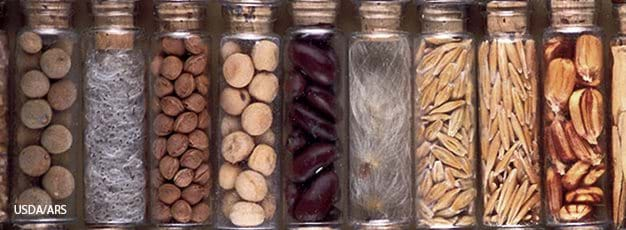Crop Genetic Diversity Boosts Production But Faces Threats

Crop yields have risen steadily over the last century, due in part to sustained research, improvements to seeds, and access to diverse genetic resources. A recent ERS report describes research that estimates a one-time permanent yield increase from genetic improvements for five major U.S. crops that generated an estimated $8.1-billion gain in global economic welfare. Consumers worldwide were the primary beneficiaries.
Crop genetic diversity is threatened by habitat loss, conversion from landraces (farmer-developed varieties) to scientifically bred varieties, and genetic uniformity in scientifically bred varieties. However, fears that loss of diversity will lead to more variability in yields have not yet materialized for major crops. This is partially the result of investments in research and breeders' continued access to genetic resources ex situ, in other words, resources collected and stored in genebanks. The U.S. National Plant Germplasm System distributes each year, for free, more germplasm samples than the United States receives from other countries. Nonetheless, a 1997 General Accounting Office study found that ex situ conservation efforts in the U.S. may fall short of meeting future crop-breeding needs.
Despite the benefits of maintaining genetic diversity, conservation of diverse genetic resources remains a challenge, in part because genetic resources have the characteristics of a public good: They are openly available and an individual holder cannot easily exclude others from using them, so the private benefits from conservation are small compared to the social benefits. The usefulness of particular genetic resources is highly uncertain, and time horizons for improving genetic resources are long. These characteristics mean that private returns to the holders of crop genetic resources are lower than their values to the world, and are unlikely to provide the incentives to achieve a socially optimal level of crop genetic diversity.
Policies to conserve genetic resources include financial assistance, stronger intellectual property rights, and international agreements. Because many diverse genetic resources lie outside the U.S., the terms of international exchange influence which germplasm is preserved and whether it can be accessed. The International Treaty on Plant Genetic Resources for Food and Agriculture, intended to preserve genetic diversity and promote exchange of germplasm, entered into force in June 2004, but key provisions to implement the treaty have yet to be negotiated.
Crop Genetic Resources: An Economic Appraisal, by Kelly Day Rubenstein, Paul Heisey, Robbin Shoemaker, John Sullivan, and George Frisvold , USDA, Economic Research Service, May 2005


